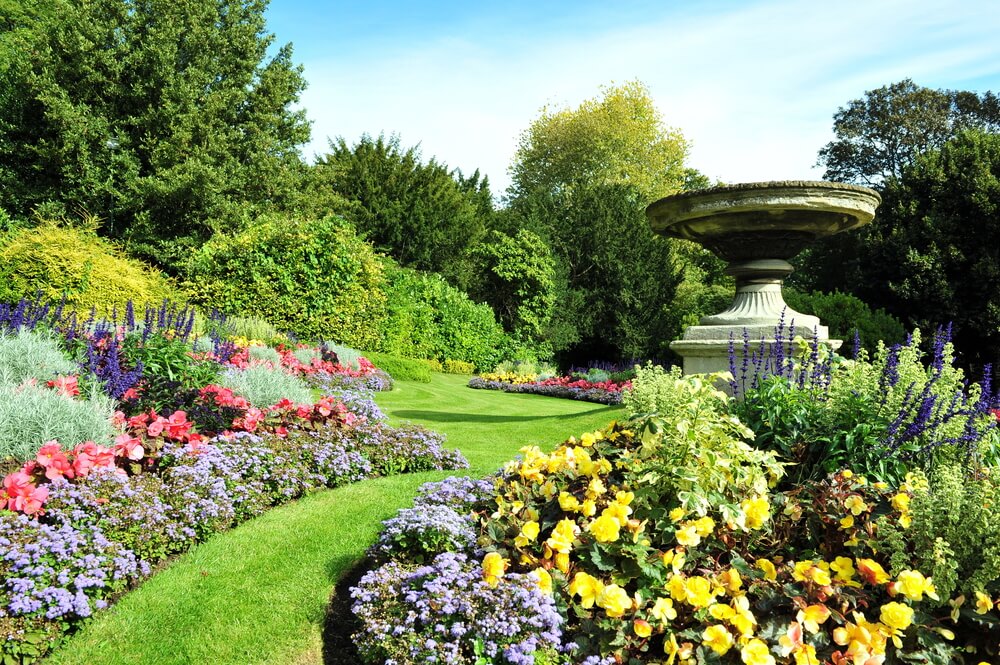Trees With Rounded Shapes For The Garden

The exteriors of the home are also part of the decoration. The idea is that a pleasing image can be presented before entering the interior. For this reason, it’s important to prepare the space well and use, for example, trees with rounded shapes for the garden.
The green touch can’t be absent. This is the only way to achieve a certain naturalism and freshness. The objective is that a degree of well-being is reached and that, in one way or another, we feel happy in a pleasant and comfortable space.
Vegetation plays a very important role, in the same way as when we incorporate paths, lights, stones, or other resources that generate scenery to meet all our expectations.
Inspiration in urban gardens: trees with rounded shapes

The municipalities usually invest a part of their budget in garden work. They want parks and recreational spaces to become areas where people can enjoy their leisure and rest time.
It’s in these enclosures where you can find trees and hedges worked in such a way that they acquire certain shapes. Undoubtedly, they attract a lot of attention and are a very attractive component.
In the background, they can be modeled in such a way that we can even obtain geometric shapes: spheres, ovals, and squares. In this way, they’ll require continuous maintenance so that the appearance remains.
We can take it as a source of inspiration for our home garden. Without a doubt, it’s a very interesting formula to generate an appropriate aesthetic principle to arouse the curiosity of your guests.
Types of trees with rounded shapes
If we’re to point out some types of trees with rounded shapes, we must first start from the species that allow this type of work to be carried out. From there, we can establish some appropriate considerations.
- One of the most common cases is Laurel. It already has an apparently spherical shape. However, we can work the surface by pruning and applying specific care to achieve a good result.
- The privet is another bush that’s in demand. This has a similar shape to the previous one and has, in turn, a taller trunk. It can be said that it attracts more attention and stands out considerably more.
- Regarding Holly, it also ranks among those with the best capabilities. It’s considered very versatile, mainly because it resists winter well, doesn’t lose its original color, its fruits are striking in color and it tolerates pruning very well.
- We mustn’t forget traditional bushes and hedges too, those that are used, fundamentally, as windbreaks to protect privacy or to delimit plots. They come in different sizes and can be worked in such a way that we can easily achieve spherical shapes.
The garden or terrace arrangement

Once we know the different categories of trees, we can analyze what the aesthetic capabilities they offer are going to be. Probably, it’ll depend on the size of the spot that we decide to place them in.
In the garden, they can occupy main places, both in the central area and along a path. Generally, they’re arranged in areas bordering other homes or the street. In fact, it’s a way of showing a more curious image from the outside.
If we want them to play a greater role, we mustn’t relegate them to the background. The important thing is that they receive considerable importance by placing them in certain places that attract attention. For example, by the pool, next to the entrance or creating a design in a central area.
Other types of trees
If we prefer other, larger species, we can resort to these: Catalpa Bungei, Arboreal Privet, or the Indian Laurel. All of these require pruning and refining work to set the rounded shape.
In this sense, a more natural area is achieved, as if we were in a field.
The exteriors of the home are also part of the decoration. The idea is that a pleasing image can be presented before entering the interior. For this reason, it’s important to prepare the space well and use, for example, trees with rounded shapes for the garden.
The green touch can’t be absent. This is the only way to achieve a certain naturalism and freshness. The objective is that a degree of well-being is reached and that, in one way or another, we feel happy in a pleasant and comfortable space.
Vegetation plays a very important role, in the same way as when we incorporate paths, lights, stones, or other resources that generate scenery to meet all our expectations.
Inspiration in urban gardens: trees with rounded shapes

The municipalities usually invest a part of their budget in garden work. They want parks and recreational spaces to become areas where people can enjoy their leisure and rest time.
It’s in these enclosures where you can find trees and hedges worked in such a way that they acquire certain shapes. Undoubtedly, they attract a lot of attention and are a very attractive component.
In the background, they can be modeled in such a way that we can even obtain geometric shapes: spheres, ovals, and squares. In this way, they’ll require continuous maintenance so that the appearance remains.
We can take it as a source of inspiration for our home garden. Without a doubt, it’s a very interesting formula to generate an appropriate aesthetic principle to arouse the curiosity of your guests.
Types of trees with rounded shapes
If we’re to point out some types of trees with rounded shapes, we must first start from the species that allow this type of work to be carried out. From there, we can establish some appropriate considerations.
- One of the most common cases is Laurel. It already has an apparently spherical shape. However, we can work the surface by pruning and applying specific care to achieve a good result.
- The privet is another bush that’s in demand. This has a similar shape to the previous one and has, in turn, a taller trunk. It can be said that it attracts more attention and stands out considerably more.
- Regarding Holly, it also ranks among those with the best capabilities. It’s considered very versatile, mainly because it resists winter well, doesn’t lose its original color, its fruits are striking in color and it tolerates pruning very well.
- We mustn’t forget traditional bushes and hedges too, those that are used, fundamentally, as windbreaks to protect privacy or to delimit plots. They come in different sizes and can be worked in such a way that we can easily achieve spherical shapes.
The garden or terrace arrangement

Once we know the different categories of trees, we can analyze what the aesthetic capabilities they offer are going to be. Probably, it’ll depend on the size of the spot that we decide to place them in.
In the garden, they can occupy main places, both in the central area and along a path. Generally, they’re arranged in areas bordering other homes or the street. In fact, it’s a way of showing a more curious image from the outside.
If we want them to play a greater role, we mustn’t relegate them to the background. The important thing is that they receive considerable importance by placing them in certain places that attract attention. For example, by the pool, next to the entrance or creating a design in a central area.
Other types of trees
If we prefer other, larger species, we can resort to these: Catalpa Bungei, Arboreal Privet, or the Indian Laurel. All of these require pruning and refining work to set the rounded shape.
In this sense, a more natural area is achieved, as if we were in a field.
All cited sources were thoroughly reviewed by our team to ensure their quality, reliability, currency, and validity. The bibliography of this article was considered reliable and of academic or scientific accuracy.
- Neff, Ludwig; Neufert, Peter: Casa. Vivienda. Jardín: el proyecto y las medidas en la construcción, Gili, 2006.
- Stevens, David: Una habitación en exterior: diseñar el jardín en casa, Blume, 2008.







